NEONATOLOGY ON THE WEB
The Nursling
Lecture 9
By Pierre Budin, Professor of Obstetrics, University of Paris; Director
of the Clinique Tarnier; Member of the Academy of Medicine, Paris, France. Authorized
translation by William J. Maloney, M.B., Ch. B., 1907.
Gentlemen,
In our last lecture we began the study of artificial feeding, and
I laid stress upon the great value of cows' milk, undiluted and
sterilised, as a food for infants.
How can we determine the amount to give in any particular case?
The capacity of the stomach is too difficult to estimate, and varies
too much, to serve as a guide. Neither is the age of use as a
standard, for sometimes an infant weighs 2600 grams at birth and
sometimes 5000 grams, and this want of uniformity is present at all
ages. The weight of the infant would probably furnish a better
indication, yet the assimilative power varies in infants of the same
weight according to the state of the digestive tube and the
composition of the milk. These are factors which further complicate
the problem.
The general tendency is towards overfeeding, and I would impress
upon you my former remark: "Infants who are underfed are free from
digestive troubles. They do not gain weight, but, by gradually
increasing the quantity, it is easy to attain in safety an adequate
diet for any given case, and then the child will grow rapidly." This
is the ruling principle in my work. Each new case is a fresh subject
for investigation. For the first few days I always prefer to err by
giving too little than by giving too much. Having gradually reached
the requisite amount for the nursling in question, I do not increase
it unless I am thoroughly convinced of the necessity.
A few examples will enable you better to grasp the details of my
method.
A woman named Liv____ was confined on April 19, 1897, of her third
child. She had never been able to suckle. The chest was quite flat,
the mammary glands were undeveloped, and the nipples were represented
only by depressions. She came to the Consultation on May 1. Her
infant weighed 3050 grams, and I prescribed 400 grams of sterilised
milk per day, divided into eight feeds. On May 8 he had lost 80
grams. I examined him carefully: as he seemed in perfect health, the
only possible explanation of the decrease in weight was that he was
being underfed. I raised his ration to 450 grams. In one week he had
gained 390 grams, and he continued to thrive, so this quantity of
milk was obviously sufficient and remained unaltered. From July 17 to
24 he had a slight attack of diarrhoea, which was quickly cured by
small doses of calomel. In the ten days ending July 27 he lost 90
grams, and was very irritable after each meal. Thinking he was
getting too little, I increased his allowance to 675 grams, and in
the following week he gained 250 grams. Similarly, on August 21, he
had gained only 60 grams in seven days. I raised the daily amount of
milk to 750 grams, and during the next week he increased at the
average rate of 51 grams per day. On October 30, 900 grams were
given, and on January 29 a little
farinaceous food was
added to the milk at one of the feeds, so as to make what we call a
"soup." On February 26 the milk was increased to 1000 grams. The
weight of this infant described practically the normal curve
(Fig. 105). My first estimate of its
needs, 400 grams of milk, was too small, but when I arrived at the
amount sufficient, 450 grams, the child increased in weight by 390
grams in one week. From time to time, when I found he was not
progressing to my satisfaction, although his digestive tube seemed to
be acting normally, I slowly augmented his daily allowance, and on
each occasion the curve rose steeply.
A baby boy, J___ M___, was born on February 1, 1898, with a weight
of 3150 grams. At first he was suckled by a wet-nurse, whose milk,
however, not being sufficient, was supplemented by asses' milk. On my
return to town after three weeks' absence I found that the wet-nurse,
having lost her milk, had weaned the child. Greatly against my
inclination I continued to feed him artificially. On my prescribing
cows' milk, undiluted and sterilised, in carefully graduated
quantities, he enjoyed complete immunity from all digestive troubles,
and his curve rose superior to the normal
(Fig. 106). The wet-nurse, although no
longer able to suckle, was retained; she was very intelligent, but
her zeal for the child's welfare often put a great strain on her
obedience. One could hardly conceive the difficulty I had in
preventing her from overfeeding the infant. She was haunted with the
idea that he was not getting enough; she was openly displeased at his
rate of growth, and pestered me to give him more milk. But as I
traced his curve from week to week and found it uniformly above the
average, I resisted her importunity to the best of my ability, and
gave way only when I thought an increase in his allowance was
absolutely necessary.
The milk given to this infant was of excellent quality, as it
contained on several analyses 40 to 41 grams of butter. It is
remarkable how small an amount the infant required.
He was given 400 grams when he weighed 4070 grams.
He was given 480 grams when he weighed 4800 grams.
He was given 540 grams when he weighed 5400 grams.
He was given 570 grams when he weighed 5800 grams.
In fact the amount he absorbed corresponded to about one-tenth of
his total weight.
A woman named Leq____ was confined at the Maternité on
December 15, 1893, of a son who, when he left the hospital ten days
later, weighed 3050 grams. The mother, unable to rear him herself,
through having to work for her living, entrusted him to a woman in
the country. We did not see him again till July 8, on which date the
mother, having gone to visit him and finding him ill with diarrhoea
and in a wretched condition, brought him to us. He had been as one of
the family, the wet-nurse had protested, and in all their food, meat,
vegetables, &c., he had shared. In the 195 days since his
departure he had gained only 2600 grams
(Fig. 107).
I prescribed eight bottles of 75 grams, i.e. 600 grams of
sterilised milk per day, and on July 15, having gained on an average
31.4 grams per day during the week, he weighed 5870 grams. On August
19, the mother left town, and I carefully instructed her to give him
the same amount of milk till her return. The infant weighed 6820
grams, and in the previous forty-two days had gained on an average 28
grams per day.
She came back on September 23. During the interval her child had
suffered almost continuously from diarrhoea, and having gained on an
average only 13.8 grams per day, he now weighed 7300 grams. On
September 28 he was given eight bottles of 75 grams, i.e. 600
grams of sterilised milk per day. On September 30 the digestive
troubles had quite disappeared, but the weight was only 7030 grams.
His daily allowance was inadequate: 600 grams of milk for an infant
weighing 7030 grams was not enough. I increased it to 675 grams per
day, and in a fortnight he had gained 470 grams. He progressed
steadily till the week ending November 18, in which I found he had
lost 70 grams. He was perfectly healthy: he weighed 8120 grams, and
absorbed 675 grams of milk per day. As this was evidently
insufficient, I gave eight bottles of 100 grams, and he began again
to increase in weight. On December 9 his ration was raised to 900
grams, and on December 23 he was given one "soup." Shortly afterwards
he caught a bad cold; he lost his appetite, and his weight
diminished. He did not take all his milk, so I reduced it to 800
grams per day. Once cured, he rapidly gained the weight he had lost.
On February 10 I found, at his weekly weighing, that he had lost 70
grams. He then weighed 9230 grams, and was getting only 800 grams of
milk per day and one "soup." He was given 900 grams, and his curve
rose steadily till it attained the average height to which hitherto
it had been inferior.
Here is another interesting case. A woman named Bon____ was
delivered at the Maternité on November 13, 1897, of an infant
weighing 3000 grams. In due course she left the hospital, and put her
child out to nurse. She returned on January 8, 1898, bringing the
infant, a letter, and a certificate. The letter was written on paper
with a gorgeous floral design round the margins; it was dated
December 30, and conveyed the congratulations of the wet-nurse to the
proud mother on the splendid progress her infant was making. She also
wished the mother a happy New Year, and gently recalled the fact that
January 1 was the time for
handsels.
A few days later a certificate arrived from the local doctor to
say that the child was so ill as to not be able to support cows'
milk, and that breast-feeding was indispensable. The poor woman
immediately sought her child, and found it in a state of collapse,
suffering from diarrhoea. Its diet had been boiled bread and milk,
and since birth it had gained only 370 grams
(Fig. 108). I recommended a breast
wet-nurse, but as nothing would induce the mother again to part with
her little one, I consented to try sterilised milk, and prescribed
400 grams per day. On January 15 the digestive troubles had greatly
diminished, the new diet was being admirably supported, and the
weight had increased by 200 grams in seven days. On this small amount
of milk the infant continued to thrive until March 19, when I had to
give 450 grams. The weight was then 5000 grams. A submaxillary
abscess appeared on March 5, and had to be incised. This slowed the
child's growth for a time, but after it healed the weight-curve
steadily rose.
The following observation shows how easy it is to give excess to
infants. A woman named Lech____ was delivered of twins on May 8,
1898. When they left the hospital ten days later, the one, Albert,
weighed 3410 and the other, Louis, 3250 grams
(Fig. 109). The mother not having
sufficient milk to satisfy both, I gave them each two 50-gram bottles
of sterilised milk per day. On this amount they continued to thrive
till July 11, when it became necessary to increase it first to 150
and then to 200 grams each per day, for the mother was gradually
yielding less and less.
On October 3 they returned from a two months' stay in the country.
I had given the mother a steriliser, so that she might suitably
prepare their milk during their absence from the Consultation. I now
found that she had weaned them completely, and was giving each a
daily allowance of 1000 grams of undiluted sterilised milk. They were
in perfect health, and weighed precisely the same, 7860 grams.
The large amount they absorbed made me somewhat anxious regarding
them. According to my experience, it was certainly excessive; I
therefore reduced it to 800 grams per day for each. This quantity was
quite large enough; their growth continued uninterruptedly, and their
curves rose steadily (Fig. 109). On
December 5, when they weighed 9220 and 9140 grams respectively, their
daily supply was increased to 900 grams. You saw them the other day,
two big, strong boys, each well worthy of the name he bears,
Lechêne [French: the oak]. This case also demonstrates
the easy transition from mixed feeding to weaning.
When infants are suffering from digestive troubles, it is
necessary first to cure them before proceeding to determine how much
milk they require for their daily needs.
On July 27, 1897, a mother brought her dying infant to me. He had
been born on May 11, and since birth had gained only 20 grams. He was
suffering from diarrhoea and vomiting, and was being fed only on
chicken broth. I prescribed 450 grams of sterilised milk per day; the
infant supported it splendidly, rallied, and soon began to gain
weight, although the diarrhoea persisted more or less till the
beginning of October. On July 31 he weighed 3300 grams, and on August
7, 3350. He was given nine bottles of 25 grams of sterilised milk,
which was a daily allowance of only 225 grams. His weight fell to
2950 grams, but the diarrhoea and vomiting now began to subside, and
soon he reached 3500 grams. He continued to thrive until October 2,
when his daily milk supply was raised to 450 grams, which on November
20 was further increased to 600 grams. In spite of influenza, a cold,
chicken-pox, and whooping-cough, each of which left its impress on
his curve (Fig. 110), little "Chicken
Broth," as he was called in the wards, weighed 11,100 grams when he
was two years old. His daily ration then consisted of 1125 grams of
sterilised milk and three "soups" per day.
An infant was brought in March 1899, weighing 5420 grams. Born on
July 30, 1898, he had since gained 2420 grams, which was a daily
average of only 11 grams. He was absorbing 1 1/2 litres of milk,
diluted with 1 litre of water, i.e. 2500 grams per day. The
mother was certain that he was yet underfed, for he cried, "as if
still hungry," after every meal. 2500 grams for an infant weighing
5420 grams is equivalent to a daily allowance of 28 litres for the
average adult of 60 kilograms. In spite of this enormous quantity the
infant was practically a skeleton; his face was seared with wrinkles,
his ribs were beaded, and the huge size of his abdomen formed a
striking contrast to his emaciated condition. He was very
constipated, and incessantly passing urine.
How was he to be dieted? As his stomach was dilated it was out of
the question to start with the average amount required by an infant
of his weight. I prescribed, amidst vehement protests from the
mother, nine bottles of 125 grams, i.e. 1125 grams of
undiluted sterilised milk per day, and on March 17 he weighed 5700
grams. During these eight days his average daily increase had risen
from 11 to 40 grams. I then essayed to reduce his allowance to 900
grams, but on March 24 I found he had lost 60 grams since the
previous weighing. As 900 grams was evidently not enough, once more I
reverted to 1125, and the curve resumed its upward course. On April
21 I again tried 900 grams, and again failed, for he lost 80 grams in
seven days. I substituted 1080 grams, and on this allowance he
reached 6530 grams on may 12. Again I ventured 900 grams, this time
with success, as you can see from his curve
(Fig. 111). He continued steadily to
increase, and on May 26 reached 6950 grams. Dieted thus, he had
gained an average 33 grams per day for forty-six days. He was now
taking only 900 grams of milk, instead of 1500 grams of milk and 1000
of water, and the wizened, ancient-looking little creature was
transformed into a plump, contented, and thriving infant.
Artificial feeding gives excellent results, but only so long as it
is attentively supervised. This fact was strikingly exemplified in
the history of the infant Leq___ (Fig.
107), and I wish further to emphasize it by briefly narrating two
other cases which demonstrate the importance of carefully regulating
the quantities of milk which the child receives.
The infant D___, born on March 23, left the hospital on April 1,
weighing 3965 grams (Fig. 112).
Breast-fed, he grew steadily, and on July 7 reached 6980 grams. The
mother, having taken him to the country, weaned him, and fed him with
1000 grams of cows' milk and two "soups" per day. When he returned to
the Consultation on November 10, he weighed 7420 grams. In 126 days
he had gained 440 grams, which was an average of only 3.5 grams per
day. His curve during this period described almost a horizontal line.
I regulated the quantity of milk he daily received, and on December 8
he weighed 8405 grams. In four weeks he had gained 985 grams, and had
thus increased at the rate of 35 grams per day. His diet was
carefully adjusted from time to time, and his curve, except for some
small oscillations due to bronchitis and teething, steadily rose. At
twelve months he weighed 9480 grams, and had eight teeth.
An infant named S_____ was brought to our Consultation on April
14, 1893, weighing 3040 grams (Fig.
113). Ten bottles, each containing 50 grams, were given to him,
and his curve made a regular ascent. On July 21 he weighed 5330
grams, and on October 13, 6840. The mother then ceased to come for a
time, and when next we saw the child, on May 4, 1894, he weighed 8430
grams; in 203 days he had increased by only 1590 grams. His curve had
entirely changed its direction; it had steadily sunk below the
normal, to which formerly it had been proceeding in parallel.
Boissard records a case which strikingly illustrates the
difference between the results of well-regulated and haphazard
artificial feeding. An infant H____, born at the Hôpital Tenon,
weighed when he left on March 19, 1899, 3150 grams. He had then been
twenty-nine days in the wards, and had gained 620 grams. The infant
was artificially fed, for the mother had no milk. He was given
carefully regulated quantities of undiluted sterilised milk, and on
April 8 he attained 3700 grams, which was an average increase of 31
grams per day for twenty days (Fig.
114). The mother became ill, and was admitted with her child into
another hospital. The infant was still fed on sterilised milk, but
his weight diminished considerably, and on May 1 he weighed only 3080
grams. In spite of her great weakness the mother, afraid for the life
of her child, insisted on leaving the hospital, and carried her
little one in all haste to M. Boissard, who found the infant much
emaciated, and suffering from an acute infectious diarrhoea.
Sterilised milk in small and accurately graduated amounts was given
till the digestive tube recovered its normal healthy state. The
infant began once more to increase, and on May 23 weighed 3680 grams,
his curve, as you see (Fig. 114), then
assuming the normal aspect.
Notwithstanding its success, artificial feeding by means of
sterilised milk is vastly inferior to breast-feeding. I cannot insist
too much upon this. The mother's milk, or that of a good wet-nurse,
should always be given where possible, for it is the easiest to
digest and entails least risk to the nursling. I have already
referred to the case of the twins Leu____, who were born at the
Maternité on December 10, 1893. The mother not having enough
milk for both, we had recourse to mixed feeding, and I gave her a
sterilising apparatus, as she lived far from the Consultation. The
infants throve, and their curves steadily rose superior to the
normal. On Saturday, July 1, the mother was obliged to entrust them
to a neighbour for the day while she went to Paris to transact some
business. On her return next morning she found them both suffering
from diarrhoea and their weights fallen, the one by 600 the other by
370 grams (Fig. 96). Under their
mother's loving care they quickly recovered, but their history
strikingly illustrates the ease and rapidity with which digestive
troubles arise when artificial feeding is improperly directed. If the
sterilisation is not perfect, if the bottle is left for some time
uncorked, if the milk is of bad quality -- in fact, if there is any
want of care in conducting the feeding -- accidents may happen which,
especially in summer, assume an extreme gravity. The smallest error
or the slightest negligence allows organisms to penetrate the milk,
which, once contaminated, becomes a menace to the infant's safety.
When, on the other hand, a nursling takes the breast, it may not
always obtain a perfect milk, but it gets, at least, a sterile food,
and enjoys immunity from acute infectious diarrhoeas.
If mixed or artificial feeding be a necessity, there are three
cardinal laws which govern the use of animal milk. 1st. Give milk of
good quality. 2nd. Give milk in correct quantities, neither too much
nor too little; and 3rd. Sterilise all milk. The small graduated
bottles, which each contain only enough for one feed, are of the
greatest service, for they prevent excess not only the daily
allowance but also in the individual meals.
I shall conclude by placing some of my results before you, but I
wish first to direct your attention for a moment to several points,
reference to which I must not neglect.
With regard to the reappearance of the menses in a nursing woman,
I shall not reiterate what I have already said. You have seen that
some menstruating women are good nurses while others are not. At the
menstrual periods nurslings may have digestive troubles, and this
applies not only to frail and sensitive weaklings
(Fig. 65) but equally to children born
at term. You may recollect the instructive curve of the infant
Calm____, upon which the mother's periods imprinted themselves as a
series of notches indicative of the temporary loss of weight
(Fig. 67).
Has the evolution of the teeth any real influence on the infant's
general health? Hippocrates made the first study of this question,
and it does not seem to be settled yet. It is a subject well worthy
of minute investigation. Many infants cut their teeth without any
signs of a general disturbance. Some present symptoms recurring at
the piercing of each tooth, for which on careful examination no cause
can be detected other than the dental evolution. The child seems out
of sorts; he is restless, fretful, and sleepless; he may have
diarrhoea, colic, and other troubles, all of which disappear the
moment the tooth emerges through the gum. To-day I wish to restrict
my examples to a few, significant of the accompanying loss of weight.
The curve of the infant Guil____, who was born on July 6, 1896,
was at first inferior to the normal (Fig.
115); but, when the mother's inadequate supply was supplemented
by sterilised milk, the child increased in weight with a most
gratifying regularity. Teeth were cut during the 26th, 47th, 48th,
and 56th weeks, and coincidentally with each, as you see, the infant
lost weight.
The infant Van der St____ was born at the Maternité on
December 6, 1896. At first he was fed exclusively at the breast, but,
the supply proving insufficient, mixed feeding had soon to be adopted
(Fig. 116). His curve is somewhat
mediocre, for the mother's milk gradually dwindled till, early in
July, the infant was completely weaned. However, on July 3, when he
was six and a half months old, two teeth appeared; others came
through on July 31, August 7, August 14 (2), December 4, and December
21, and the curve shows that at these periods the weight either
remained stationary or diminished. The same phenomenon is observed on
the curves of the infants Liver____ (Fig.
105) and Go____ (Fig. 68).
After a period which varies within wide limits, the mother's milk
ceases to be sufficient for the infant's needs. Either it quality
deteriorates or its amount diminishes. It is then necessary to
substitute cows' milk or other foods, and this constitutes weaning.
Weaning is not always an easy matter. Some infants persistently
refuse every other form of nourishment but the breast. Most of you
remember the woman Dubois. She was an excellent nurse, and for a long
time her little son throve to my entire satisfaction. But the mother
gradually lost her milk, and, in spite of all we could do, the child
absolutely refused to take anything but the breast. He soon ceased to
grow, and, little by little, dwindled away till he was but a shadow
of his former splendid self. I tried him with sterilised cows' milk,
sweetened and unsweetened, "soups" made with milk, and other forms of
nourishment too numerous to mention, but all without avail. Such
infants soon waste considerably, and your ingenuity will often be
severely taxed in trying to steer them through this difficult period
of weaning.
Similar cases are not rare among infants suckled by their mothers,
but they are much more common among those entrusted to wet-nurses. To
a wet-nurse weaning may mark the termination of her engagement; it
is, therefore, not to her financial interest to facilitate the
process. Not infrequently she pleads her inability to get the infant
to take anything but the produce of her breasts, but her efforts
require very little discouragement. She would soon devise some means
of supplementing her inadequate supply if it were a question of her
own child, but when it concerns only the nursling she is hired to
suckle, her finer feelings become submerged in her business
instincts.
On the other hand, weaning is an easy matter when an infant,
besides the breast, has been accustomed to take one or two bottles of
sterilised milk daily. All that is necessary is gradually to increase
the number of bottles per day, and the child will be rapidly and
safely weaned. Many mothers train their infants in this way from the
beginning -- some because they have not quite enough milk, others
because they do not wish their night's rest interrupted; yet again
others have duties which take them away, and sterilised milk replaces
breast-feeding during their absence. These mothers can wean their
children very readily, as you will have occasion forcibly to realise
if you leave them to their own discretion.
Infants are not fed exclusively on cows' milk after they are
weaned: they are also given light "soups," prepared from milk and
farinaceous substances, such as arrowroot, tapioca, racahout, rice,
potatoes, wheat, oats, barley, &c. At first, the "soups" contain
only a small amount of
feculent matter, which is very
thoroughly cooked. Some practitioners do not employ them till after
the first year, but I have often given them earlier. I have
frequently heard doubts expressed as to the utility of these "soups,"
but I think it is easy to prove that they are often of the greatest
nutritive value. They are made with a portion of the infant's daily
allowance of milk, and on adding one "soup" to the dietary of a
stationary infant, without in any way altering his quantity of milk,
I have frequently seen his weight begin steadily to increase.
A woman named Mer____ was sent to me by the Superintendent of the
Hôpital Cochin. She had weaned her newly-born infant, because
she had to work for a living, and he asked me to grant her the daily
milk required by the child. The feeding was therefore exclusively
artificial. If you examine the curve (Fig.
117), you will see that on June 10 the infant was receiving 900
grams of milk and one "soup." On June 24 a second was given, and this
sufficed, without any augmentation of the daily milk allowance, till
November 18. Yet, in this interval, the child having increased from
7100 to 9500 grams, had gained 2400 grams.
Another woman, called Fi____, was delivered on June 19, 1896, and
when she returned from a convalescent home on July 25, she no longer
had any milk. She was not one of my patients, but the Director of the
Maternité, moved to compassion by the poor woman's extreme
solicitude for her child, asked me to direct its feeding, and to
supply it with the necessary milk. At first I gave 400, then 600, and
on January 23, 1897, 1000 grams of sterilised milk per day. On March
6 the first "soup" was ordered, and on April 24 another was added,
yet till June 26 the quantity of milk remained unaltered. The infant
had continued steadily to increase, owing to the influence of a few
teaspoonfuls of flour made into "soups" with the milk
(Fig. 118).
As a rule I do not allow broths, gravies, nor any other foods. I
prescribe only milk or "pap" made with milk during the first two
years. When they have completed twenty-four months they are
discharged from the Consultation, but the greater number are brought
back from time to time by their proud and grateful mothers for my
inspection.
I have now outlined my methods of infant feeding. How have they
been justified by results? This you may judge for yourselves,
gentlemen, any day you care to visit our Consultation.
It has been said that infants reared on mixed, and especially on
artificial feeding, are fat and flabby, and have very little
resisting power to disease. They are alleged to be prone to all sorts
of evils -- abdominal enlargement, a special form of dyspepsia
arising from the use of undiluted milk, rickets, eczema,
scurvy-rickets, &c.
The tumid abdomen is almost
unknown among my nurslings. I have met with it in only one case. The
child in that instance was receiving 2 1/2 litres of diluted milk per
day, and on reducing his allowance to 900 grams, his abdomen regained
its normal volume.
I am absolutely unacquainted with the so-called "undiluted milk
dyspepsia." We always inquire as to the colour of the infant's
stools, and the mother almost invariably replies that it is yellow.
White stools of the consistency of putty, the pathognomonic sign of
the new dyspepsia, indicate merely that the infant is is being
overfed. We never see them, for we do not overfeed; it is rarely that
we need to prescribe more than 1000 to 1200 grams of milk even for
infants in their second year.
As for rickets, not a single case has occurred in any of my
Consultations since I first began in 1892. One was sent to me from
the dispensary of one of my colleagues. You may remember I described
it to you; the poor little unfortunate was getting 2500 grams of
fluid per day.
A distinguished doctor came from Budapesth not long ago in order
to see my Consultation. He had been accustomed to believe all sorts
of accusations against undiluted sterilised milk as an infant's food.
To convert him from error and remove his doubts I had all of the
children stripped, and then invited him to examine them. This he did
with the greatest care, but to his profound surprise did not find a
single child which presented even a trace of rickets.
Neither will you see eczema among our little patients. Since 1892
I have observed only two cases, both of which were suckled by mothers
indulging to excess in food and drink. I have given you my opinions
on this subject in an earlier lecture
(Fig. 64). Our infants on mixed and
artificial feeding are never affected with eczema, for they are not
overfed, they are free from digestive troubles, and they are kept
clean.
Tuberculosis we practically never see, for we distribute nothing
but sterilised milk.
As for the so-called "infantile scurvy" which is alleged to follow
the use of sterilised milk, I have heard a very great deal about it
during the last few years, but I am still looking for my first case.
What constitutes these "antiscorbutic properties" of fresh milk? I do
not understand how sterilisation causes them to disappear.
Infants fed on animal milk are also alleged to be without strength
and resistance, although heavy and fat. This has not been my
experience. Mothers, from time to time, bring back my former little
patients to see me, and I have always found that in general health
and physique they would compare favourably with any children of their
age.
In our next lecture, the last on the subject of infant feeding, I
shall discuss in detail the organisation of Consultations for
Nurslings and their results.
|
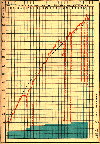
|
Fig. 105. Quantities of pure milk taken by an infant on
artificial feeding.
|
|
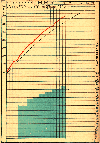
|
Fig. 106. Showing the quantities of undiluted milk taken
by an infant on artificial feeding.
|
|
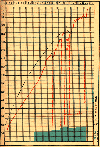
|
Fig. 107. Artificial feeding. Curve of the infant Leq___,
showing the daily quantities of milk he took.
|
|
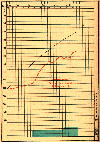
|
Fig. 108. Infant badly fed by a wet-nurse. Curve showing
the results of regulated feeding by undiluted, sterilised
cows' milk. Daily quantities of milk indicated in blue.
|
|
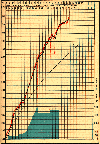
|
Fig. 109. Mixed feeding of twins. At first a small
quantity of cows' milk sufficed, but the mother went to the
country, and in spite of my advice greatly increased the
amount. On her return I diminished it. Quantities of cows'
milk taken per day are indicated by the blue columns.
|
|

|
Fig. 110. Infant admitted in a dying state, suffering
from diarrhoea and vomiting. Artificial feeding -- recovery.
Curve shows the effect of various contagious diseases on the
infant's weight. Quantities of milk per day in red.
|
|
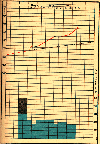
|
Fig. 111. Curve of a rachitic admitted to the
consultation. His daily allowance was 2500 grams of fluid. I
first gave him 1125 grams of undiluted milk, which I
ultimately succeeded in reducing to 900 grams.
|
|
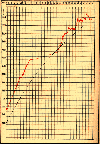
|
Fig. 112. Curve of an infant who, while attending the
Consultation, was breast-fed. Mother went to the country and
weaned him. His weight during this period was practically
stationary. When the artificial feeding was properly
directed his curve rose. The interrupted red line represents
the curve during his absence from the Consultation.
|
|
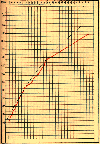
|
Fig. 113. Artificial feeding. Curve of infant S____.
Ceased to attend the Consultation on the twenty-seventh
week; returned on the fifty-sixth. Observe the change in
direction of the curve during this period.
|
|
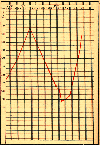
|
Fig. 114. Artificial feeding carefully supervised, the
infant grew normally; badly directed, the infant had
diarrhoea and lost weight; feeding again properly regulated,
diarrhoea ceased and the infant rapidly increased
(Boissard).
|
|
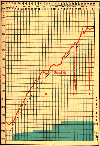
|
Fig. 115. Feeding first mixed, then artificial. Curve
shows the effect of teething on the weight. D, Evolution of
a tooth.
|
|
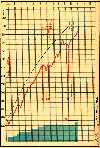
|
Fig. 116. Feeding first mixed, then artificial. Showing
the effect of the dental evolution on the infant's weight.
D, Evolution of a tooth.
|
|
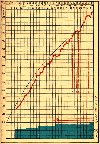
|
Fig. 117. Artificial feeding. Daily allowance of milk
from the thirty-fourth to the fifty-seventh week was 900
grams. In this interval the weight rose from 7100 to 9000
grams, and the diet had been augmented by two "soups" only.
|
|
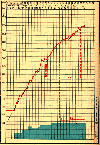
|
Fig. 118. Feeding first mixed, then artificial. Curve
showing the effect on the weight of the addition of "soups"
to the infant's diet.
|
Return to The Nursling Contents Page
Created 2/21/97 / Last modified 2/21/97
Copyright © 1998 Neonatology on the Web / webmaster@neonatology.net













